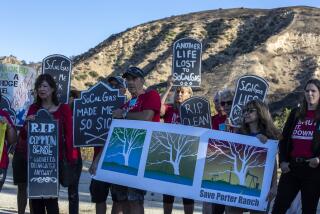Gas Storage Tanks ‘Time Bombs’ Threatening State’s Water Supply
LOS ANGELES — Most people like the convenience of driving only a few blocks to their corner gas station for a fill-up.
What many do not realize is that beneath the friendly neighborhood pumps lie thousands of storage tanks leaking gasoline and other cancer-causing toxic chemicals into California’s precious supplies of drinking water.
Lawyer Barry Groveman, former chief environmental prosecutor for the Los Angeles County district attorney’s office, said the state water resources board estimates that “100% of underground tanks will leak sometime in their life span.”
“It’s the most staggering statistic I’ve ever heard,” said Groveman, who co-authored the anti-toxics Proposition 65 approved by voters in 1986.
“(The tanks) are ticking time bombs,” he said.
Statewide, there are about 148,000 underground storage tanks, and leaks have been found at 5,106 sites, said Harold Singer, chief of the land disposal branch of the state Water Resources Control Board. On average, there are 2.5 tanks per site, he said.
About 34,000 tanks are scattered throughout Los Angeles County and 9,450 in Orange County, Singer said. About 864 sites in Los Angeles County have leaking tanks and Orange County has 586.
“In California, 20% of the water supply is contaminated,” Groveman said.
“No one disputes that underground storage tanks contribute significantly to the problem. We’ve closed up to 250 wells in Los Angeles County.”
Closure of local drinking-water wells means that residents in the Los Angeles basin have had to rely more and more on Northern California and other outside sources to quench their thirst.
The tanks pose an especially dangerous threat in areas with high ground-water tables, such as the San Gabriel Valley northeast of Los Angeles.
Hazardous Substance
Gasoline is one of the most hazardous substances around, said James McNally, senior hazardous materials specialist for the state Department of Health Services. It contains such toxic chemicals as lead and the cancer-producing products benzene, toluene and trichloroethylene.
But not until the last five or 10 years was much thought given to the environmental hazards posed by leaking tanks, Groveman said.
Beginning in January, 1984, a set of laws went into effect under legislation sponsored by Assemblyman Byron D. Sher (D-Palo Alto), requiring monitoring of existing tanks for leaks and tougher standards for new tanks.
New tanks are required to have double walls or be placed in vaults so toxic materials are contained when leaks occur.
The legislation also requires counties to identify all underground tanks with their jurisdictions and issue permits for them to make sure they comply with the new law.
A three-year battle followed in the state Legislature over how to pay for a massive clean-up of all the leaking sites that ended this year with the adoption of another Sher bill establishing a pilot program. Initially, $1.5 million in federal money and $7.5 million in state money will be used for contracts with local health departments to hire people to clean up the contaminated soil.
Local governments will keep track of the costs to clean up each site and the state will then bill the company or individual responsible for the contamination.
Ten counties and two regional agencies are included in the pilot program, Singer said. Los Angeles County did not apply for the clean-up money.
Meanwhile, local agencies are running into problems with the 1984 legislation.
Monitoring Systems Faulty
A survey last year of underground storage tanks in Los Angeles equipped with monitoring systems to detect leaks found 60 percent were not functioning, said John Kitchens, an inspector with the city Fire Department’s underground storage tank unit.
Either the monitoring equipment was not installed properly or it was shut down or turned off by gas station operators who did not know how it worked, Kitchens said.
Replacing old or leaking tanks is expensive, costing from $120,000 to $150,000 per tank, said Al Greenstein, a spokesman for Los Angeles-based Atlantic Richfield Co.
Since 1980, Arco has spent $25 million on testing and replacing tanks, Greenstein said. He said the company tests its tanks every three years and all are equipped with leak monitoring systems.
Gas stations owned by the major oil companies are not as much of a problem as those that have been abandoned or are independently owned and operated, said McNally of the Health Services Department.
To address this problem, the state Legislature passed a bill last year to provide low-interest loans to small business owners to help them replace or repair old and leaking tanks.
More to Read
Sign up for Essential California
The most important California stories and recommendations in your inbox every morning.
You may occasionally receive promotional content from the Los Angeles Times.










